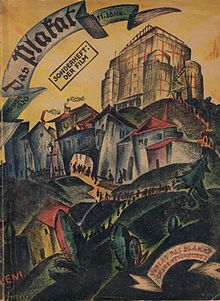Paul Leni
This article needs additional citations for verification. (November 2009) |
Paul Leni | |
|---|---|
Los Angeles, California, U.S.[1] | |
| Nationality | German |
| Occupation(s) | Film director, art director |
| Years active | 1913–1929 |
| Notable work | |
| Movement | German Expressionism |
Paul Leni (born Paul Josef Levi; 8 July 1885 – 2 September 1929) was a German filmmaker and a key figure in
Life and career

Paul Josef Levi was born to a Jewish family
In 1913, he started working in the German film industry designing film sets and/or costumes for directors such as
During World War I, Leni started directing as well with films such as Der Feldarzt (Das Tagebuch des Dr. Hart, 1917), Patience (1920), Die Verschwörung zu Genua (1920/21) and Backstairs (1921). In 1923 he participated in the creation of the theater cabaret-cafe Gondola in Berlin.
Leni designed short prologues for festive film premieres in Berlin cinemas, such as Lubitsch's Forbidden Paradise (1924), Herbert Brenon's Peter Pan (1924), and E. A. Dupont's Variety (1925).
In 1927, he accepted
His final film was The Last Warning, envisioned as a companion film for The Cat and the Canary due to its predecessor's popularity.[3] Leni died in Los Angeles on 2 September 1929, of sepsis brought on by an untreated tooth infection,[4] only eight months after its release.[5] He was 44.
Filmography
German films
As art director
- Ein Ausgestoßener (1913) (dir: Joe May)
- The Man in the Chot of AMSA ZUBAIR (1914) (dir: Joe May)
- The Armoured Vault (1914) (dir: Joe May)
- Der Katzensteg (1915) (dir: Max Mack)
- Der Blusenkönig (1917) (dir: Ernst Lubitsch)
- The Ring of Giuditta Foscari (1917)
- Veritas Vincit (1919) (dir: Joe May)
- Intoxication (1919) (dir: Ernst Lubitsch)
- E. A. Dupont)
- The Vulture Wally (1921) (dir: E. A. Dupont)
- Lady Hamilton (1921) (dir: Richard Oswald)
- Children of Darkness (1921)
- Frauenopfer (1921/22) (dir: Karl Grune)
- Tragedy of Love 1922) (4 parts, dir: Joe May)
- The Countess of Paris (1923)
- The Farmer from Texas (1925) (dir: Joe May)
- The Wife of Forty Years (1925) (dir: Richard Oswald)
- Dancing Mad (1925) (dir: Alexander Korda)
- Manon Lescaut (1926) (dir: Arthur Robison)
- Einspänner Nr. 13 / Fiaker Nr. 13 (1926) (dir: Michael Kertész)
- The Golden Butterfly (1926) (dir: Michael Kertész)
- Maytime (1926) (dir: Willi Wolff)
As director (and art director)
- 1917 Dr. Hart's Diary/ Der Feldarzt / Das Tagebuch des Dr. Hart
- 1917 Prima vera
- 1917 Dornröschen
- 1918 The Mystery of Bangalore
- 1919 The Platonic Marriage
- 1919 Prince Cuckoo
- 1920 Patience
- 1920/21 The Conspiracy in Genoa
- 1921 Hintertreppe (dir with Leopold Jessner)
- 1924 Waxworks (Das Wachsfigurenkabinett)
- 1925/26 Rebus-Film Nr. 1–8 (series of short films)
Universal Studio films
- The Cat and the Canary (1927)
- The Chinese Parrot (1927)
- The Man Who Laughs (1928)
- The Last Warning (1928/29)
References
- ^ a b c d "BFI database: Paul Leni". bfi.org.uk. Archived from the original on 17 November 2016. Retrieved 16 November 2016.
- ISBN 978-0813548333.
- ^ Atkinson, Michael. "The Last Warning". silentfilm.org/. Archived from the original on 17 November 2016. Retrieved 16 November 2016.
The kind of party we're in for was immediately familiar to audiences in 1929 because of the intense popularity two years earlier of Leni's The Cat and the Canary—to which The Last Warning is devised to be a companion film, almost a redux.
- ^ Landazuri, Margarita. "The Cat And The Canary". silentfilm.org/. Archived from the original on 18 December 2017. Retrieved 16 November 2016.
He died on September 2, 1929, of blood poisoning caused by a neglected tooth infection. He was 44 years old.
- ^ Atkinson, Michael. "The Last Warning". silentfilm.org/. Archived from the original on 17 November 2016. Retrieved 16 November 2016.
was the final film for the illustrious Leni who died eight months after its release of blood poisoning at the age of forty-four.
